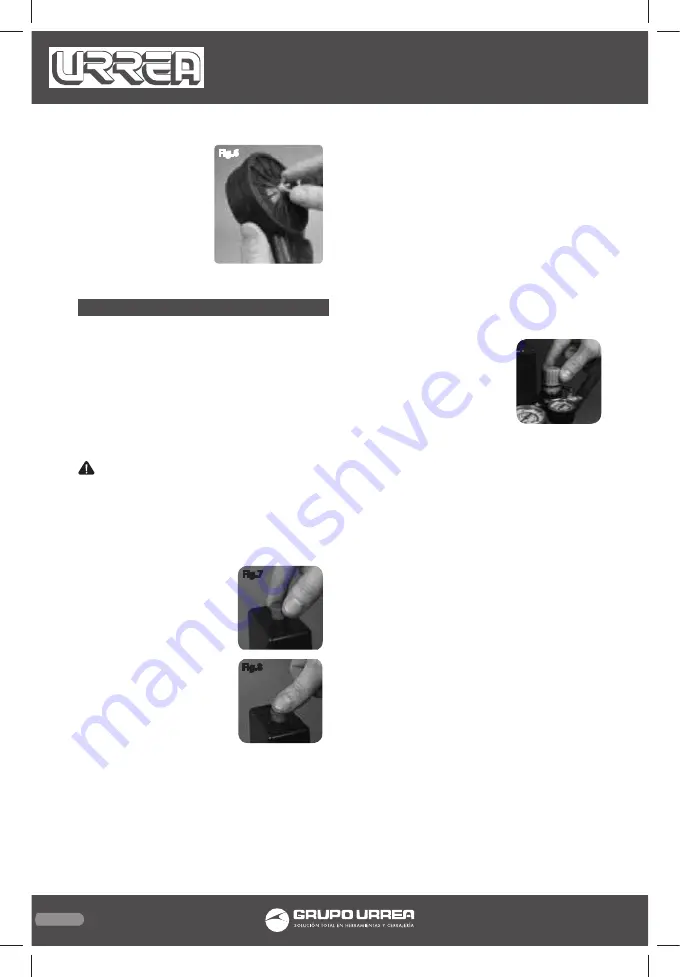
14
4. Push out the centre
mounting piece and
screw this into the air
inlet as firmly as pos-
sible with your fingers
(Fig.6).
5. Replace the air filter
holder, then the air fil-
ter, cover and washer
and wing nut.
OPERATION INSTRUCTIONS
PRE-START ROUTINE
1. Ensure that the location for the compressor
is clean, dry and well ventilated.
2. Ensure the crank case has been filled with oil and
is at the correct level, and the air filter has been
fitted.
For the first time of operation, run the com-
pressor for 10 minutes with no load and with
the outlet valve open to ensure all parts are
well lubricated.
WARNING: Be aware that pressurised air will
be discharged from the outlet and care should
be taken that this discharge is not directed
towards you the operator, or other persons
within the area.
TO START & STOP THE COMPRESSOR
1. Check the rating label on
the compressor indicates
120 V.
2. Plug in the mains cable of
the compressor to a stand-
ard 120 V household power
point and turn on.
3. To start the compressor,
lift the ON/OFF switch on the
pressure switch cover (Fig. 7).
4. To stop the compressor,
push the ON/OFF switch
down (Fig. 8).
OPERATION
1. The pressure in the tank is controlled by the
action of the pressure switch located under
the pressure switch cover. When the set maxi-
mum pressure is reached the pressure switch
activates and the motor is switched off.
The pressure then decreases as the air is used
by the connected tool until the set minimum
pressure is reached after which the pressure
switch causes the motor to switch on again.
The operator of the compressor should be well
aware that during use of the compressor the
motor will start and stop under the influence
of the rising or falling pressure in the tank. The
motor will start without any warning.
2. The maximum and minimum pressures are
factory set and the operator should not try to
change them.
3. The outlet on the compressor can be regu-
lated.
4. The pressure of the air
outlet can be changed,
by turning the regulating
knob (Fig. 9). Rotate the
knob clockwise to increase
pressure and anti-clock-
wise to decrease pressure.
NOTE: To obtain the correct output reading
on the regulated output gauge, the air must
be flowing through the outlet. The regulating
valve should be adjusted and the gauge read
with the outlet valve open and the air being
discharged from the regulated outlet through
the accessory being used. To increase the air
pressure, rotate the regulating valve clockwise.
To decrease the pressure, rotate the regulating
valve anti-clockwise.
NOTE: If you do not allow the air to discharge
while you are setting the regulator, the pres-
sure as indicated on the regulated outlet
gauge will be incorrect. This gauge ONLY in-
dicates the correct pressure while air is being
discharged from the outlet.
5. On completion of the task, i.e. when you
have finished using the compressor, or when
you are leaving the compressor unattended,
turn off the compressor in the following way:
• Press down the on/off switch.
• Wait for the pressurised air to bleed from the
release valve under the pressure switch cover.
NOTE: When you press the button down you
should hear a short air discharge (Approx. 1/2
second).
• Switch off the electrical power supply and re-
move the electrical plug.
Fig.6
ON
OFF
Fig.7
Fig.8
Fig.9
COMP825-850 manual.indd 14
02/12/15 9:32 a.m.
















